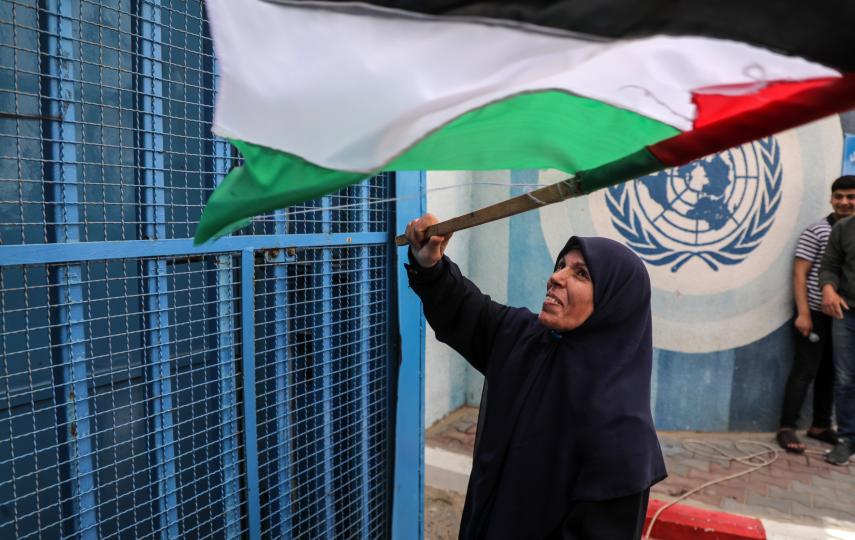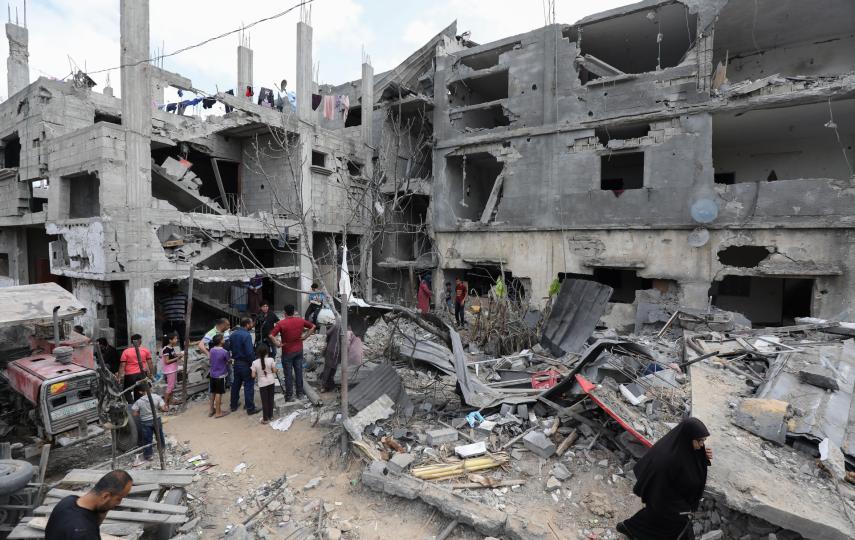The humanitarian fallout from Israel’s bombardment of the Gaza Strip has been swift, widespread, and indiscriminate, according to local aid workers, who are urgently calling on the international community to establish a safe corridor for the delivery of assistance and supplies as residents of the coastal enclave brace for a likely ground invasion.
“There is an impending humanitarian crisis,” Mohammed Abu Mosabeh, a spokesperson for the Palestinian Red Crescent Society in Gaza, told The New Humanitarian. “In all our years of experience of being under fire, this is by far the fiercest and most aggressive assault on Gaza by occupation forces,” he added, referring to the Israeli military.
“In previous attacks, our paramedics were protected under the International Committee of the Red Cross (ICRC) regulations. This time, the ICRC told us from the get-go that the occupation forces reject insuring the safety of our paramedics,” Abu Mosabeh said. “There are also no warnings before the targeting of residential units, resulting in massive numbers of casualties.”
The Israeli bombardment began on 7 October in response to an unprecedented attack by Hamas, the Palestinian militant group that governs the Gaza Strip. Breaching the security barrier surrounding Gaza, Hamas fighters attacked Israeli towns, cities, and a music festival, leaving at least 1,300 people dead, kidnapping 100-150 others, and injuring thousands more, according to Israeli officials.
Israel, which since 2007 has maintained a blockade of Gaza – controlling its borders, airspace, shoreline, and what goods can enter and exit – announced on 9 October that it was imposing “a complete siege”, cutting electricity and water and blocking the entry of food and fuel to the territory’s population of 2.1 million people. Around half of that population is under the age of 18.
Israel has closed the crossings at Erez and Kerem Shalom. Egypt has vowed to try and keep the only other crossing, at Rafah, open, but it has been reportedly hit by Israeli airstrikes and daily numbers allowed to cross even when it is running normally are limited to around 400.

UN agencies have called on Israel to lift the siege of Gaza, saying that denying people life saving assistance is prohibited under international humanitarian law.
As of the morning of 12 October, more than 1,200 people in Gaza had been killed by Israeli bombing and shelling since the fighting began, and more than 5,000 – around 60% of whom are women and children – had been injured, according to Palestinian health officials. Paramedics and journalists are among those who have been killed.
“We’re lucky to have survived this far, but till when?”
“There’s nowhere safe. Where do we go?” Fatma, a 38-year-old mother of seven, told The New Humanitarian on 10 October as she stood barefoot, weeping and hugging her children, in the hallway of a Red Crescent hospital. The family was covered in dust and blood from various injuries from an airstrike that hit their house in al-Araishiya, a neighbourhood in the southern Gazan city of Khan Younis, and that left Fatma’s husband in critical condition.
“[Gaza] is being wiped out, and those whose houses are still standing are taking in those who lost their homes because the shelters [run by the UN Relief and Works Agency for Palestinian Refugees (UNRWA)] are overflowing,” said Jabril, who asked to go by his first name due to the current security situation.
Jabril, 42, his wife, and their five kids had left their home – full of a lifetime of possessions and memories – in al-Daraj, a densely populated area of northwest Gaza, when they heard another Israeli airstrike approaching the neighbourhood on 10 October. The streets outside had already been pounded to rubble by earlier strikes. The family headed to a relative’s home in Gaza City that had so far not been as heavily targeted, but the small house was already packed with panic-stricken people seeking shelter.
“I left them there – my wife and kids – and went to my sister’s, because there was no room for all of us to stay,” Jabril said. “We’re lucky to have survived this far, but till when?”
Meanwhile, Gaza’s sole power plant ran out of fuel and shut down on the afternoon of 11 October, internet connectivity has also been cut in much of the territory, as has the water supply, which is controlled by Israel, and the enclaves overwhelmed hospitals are running critically low on medical supplies and fuel to power backup generators.
Israel has also bombed the Gaza’s Rafah border crossing with Egypt three times since the fighting began, and Egypt has said that it won’t allow people fleeing Israel’s bombardment to enter the country, effectively leaving Palestinians no exit and raising questions about whether humanitarian aid will be allowed to enter as existing supplies run out fast.
“Relief and entry of essential supplies into Gaza must be facilitated – and the UN will continue efforts to provide aid to respond to these needs.” UN Secretary-General António Guterres said on 9 October, after condemning Hamas’ attack and expressing concern about Israel’s targeting of civilians and civilian infrastructure in Gaza.
“I urge all sides and the relevant parties to allow United Nations access to deliver urgent humanitarian assistance to Palestinian civilians trapped and helpless in the Gaza Strip,” he added.
Mass displacement, dwindling supplies, and aid access concerns
Fatma and Jabril are just two of the more than 330,000 people to have been displaced by Israel’s bombardment of Gaza by 11 October, as entire neighbourhoods and residential buildings have been reduced to rubble. More than 175,000 of those have taken shelter in 88 schools run by UNRWA across the Gaza Strip. But even those facilities are not necessarily safe.
“So far, 18 UNRWA facilities have been hit, including the headquarters of UNRWA, which is now inoperable,” Adnan Abu Hasna, spokesperson for UNRWA in Gaza, told The New Humanitarian by phone on 10 October. “I was removed from beneath the rubble two days ago when the headquarters were targeted with us inside.”
UNRWA’s reserves of medications, health kits, and food to offer the displaced population are running out fast, Abu Hasna continued.
“We are providing the displaced with meals, water, healthcare, mental health, as well as covers and beddings, but these are in short supply," he said, adding that there are no new supplies coming in to replenish its stockpiles. “Israel previously allowed a border crossing to open two or three days into a war, but today, it's refusing any window of aid coming in.”
The Egyptian Red Crescent has reportedly sent more than two tonnes of medical supplies into Gaza, and there are efforts underway to organise more aid deliveries. But it is unclear how the repeated bombing of the Rafah crossing will affect aid access.
“We received a small convoy of medical supplies from the Egyptian Red Crescent for which we’re grateful for,” Abu Mosabeh confirmed. “But that was it,” he added, there was nothing else coming in.
UNRWA was getting by on a day-to-day basis, according to Abu Hasna. “We, as UNRWA, have fuel reserves that can last us between six to 10 days. We can’t store more reserves than that, and if this runs out, we’ll fail to perform our role,” he said. “We should be able to provide care for Palestinians during times of calm and war.”
Need for a humanitarian corridor
Abu Mosabeh urged the international community to demand the creation of a safe corridor for paramedics to reach and treat those wounded. “Our medical teams are being targeted. By Tuesday, 15 ambulance vehicles had been hit and were out of service, five paramedics killed, and 15 others injured.” he said.

“This is a blatant violation of all international treaties and laws. The intentional destruction of infrastructure adds to the complexity of our mission. The targeting of civilians without warnings has also resulted in larger numbers of casualties, requiring immense efforts to salvage them from beneath the ruins and treat them,” he added.
He explained that there are 500 trained volunteers from Gaza’s civil society who are ready to join in rescue efforts once fuel runs out and ambulances can no longer be used to reach the wounded, but there is also an urgent need to create a humanitarian corridor for relief to come in and to allow for the injured to get proper care.
With an Israeli ground offensive appearing imminent and continued rocket fire from Gaza toward Israel, there is no apparent end to the violence in sight, and the concerns of aid groups about being able to meet the skyrocketing needs are only growing.
Mohamed Qadous, head of Palestine office of charity organisation Rahma Worldwide, said they were able to source hundreds of meals for the displaced as well as some medications from the local market through donations from Kuwait.
“But this is not sustainable,” he said. “What we can provide from within Gaza is very limited compared to the catastrophic situation unfolding. We need medicine, fuel, food, water, clothes, and more. The world needs to make sure a safe pathway is created for us to be able to get essential supplies and treat our injured.”
This article is produced in collaboration with Egab. Edited by Eric Reidy.





